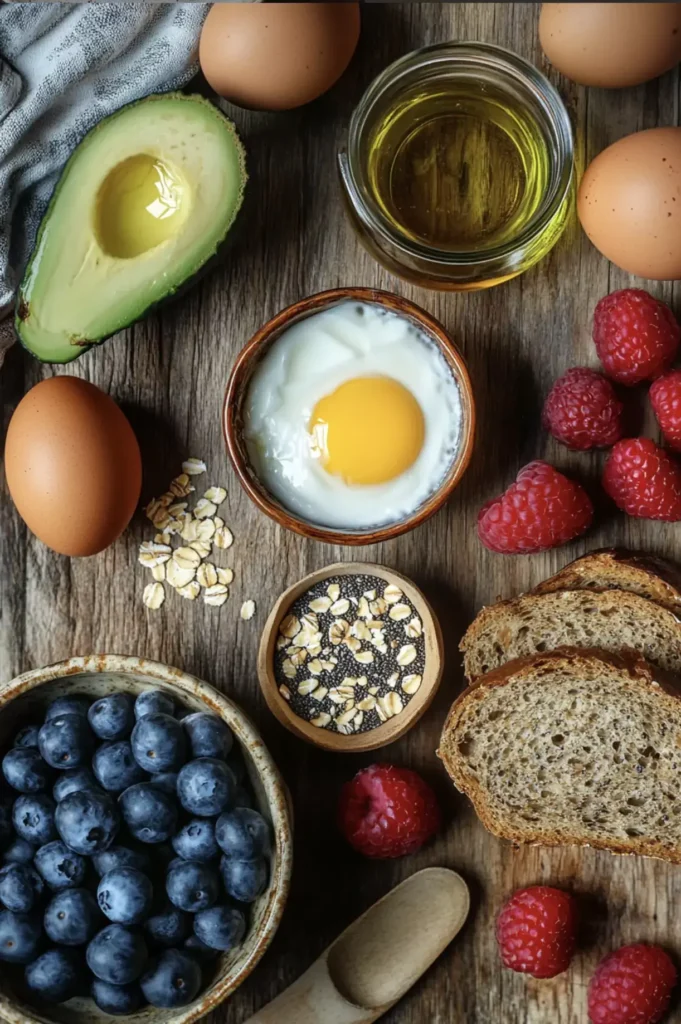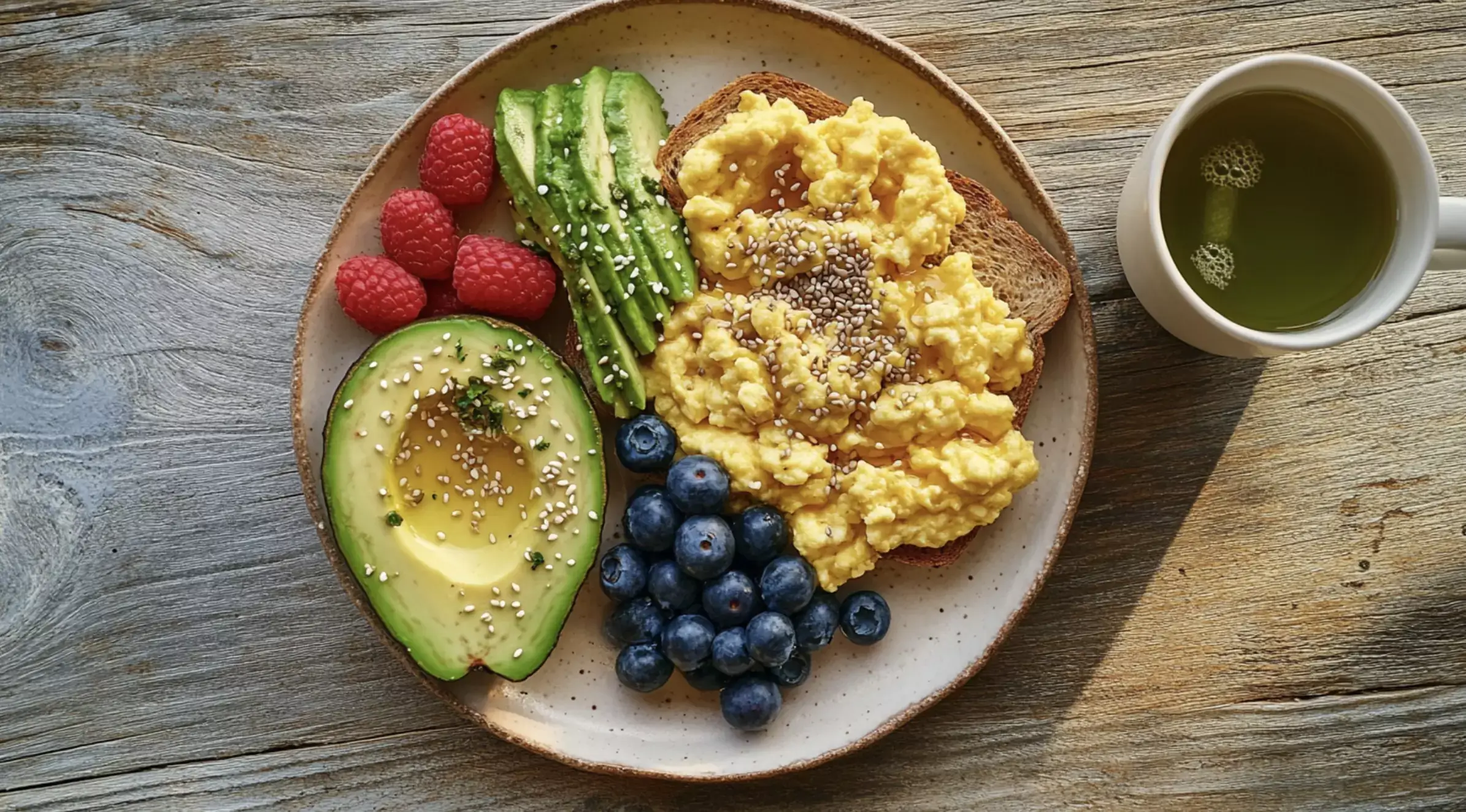Have you ever started your morning with a meal that left you sluggish instead of energized? You’re not alone! The truth is, not all breakfasts are created equal, and certain choices can drain your energy rather than fuel it. A balanced breakfast isn’t just about eating something in the morning—it’s about choosing nutrient-dense, energy-boosting foods that support your metabolism, mental clarity, and sustained energy levels.
If you’ve been feeling that mid-morning crash, your Breakfast DTI (Daily Total Intake) might need a little tweaking. The good news? A few small changes—like adding protein, fiber, and healthy fats—can make a huge difference in how you feel throughout the day. Whether you’re a fan of smoothies, high-protein pancakes, or wholesome toast options, there’s a perfect way to start your morning right.
Let’s dive into the common mistakes that could be sabotaging your energy and how you can fix them with delicious, easy-to-make breakfast choices!

Breakfast DTI
Ingredients
High-Quality Protein for Long-Lasting Fullness
- Protein is a game-changer when it comes to avoiding mid-morning crashes. It keeps you satisfied longer stabilizes blood sugar levels, and helps with muscle repair. Consider adding:
- Eggs – A powerhouse of protein healthy fats, and brain-boosting choline
- Greek yogurt – A creamy protein-rich option that also supports gut health
- Cottage cheese – Packed with protein and calcium while being low in sugar
- Tofu or tempeh – A great plant-based alternative high in protein and essential amino acids
- Nut butters – Almond peanut, or cashew butter adds a satisfying dose of protein and healthy fats
Healthy Fats to Keep Energy Levels Steady
- Skipping fats in the morning can leave you feeling hungry too soon. Adding healthy fats helps slow digestion keeping energy levels stable while improving brain function. Some great choices include:
- Avocado – Rich in heart-healthy monounsaturated fats and fiber
- Nuts and seeds – Walnuts chia seeds, and flaxseeds add crunch and nutritional benefits
- Coconut oil or olive oil – A smart choice for cooking or drizzling over breakfast dishes
- Full-fat dairy – If you tolerate dairy options like whole-milk yogurt provide beneficial fats
Complex Carbohydrates for Lasting Energy
- Not all carbs are the same. Choosing slow-digesting fiber-rich carbohydrates ensures a steady release of energy, preventing blood sugar spikes and crashes. Smart carb choices include:
- Oats – A fiber-packed grain that supports digestion and sustained energy
- Quinoa – A high-protein grain alternative with a rich texture
- Sweet potatoes – A nutrient-dense naturally sweet option that pairs well with eggs or nut butter
- Whole grain bread – A better choice than refined white bread for lasting energy
Antioxidant-Rich Fruits and Vegetables
- Adding a variety of colorful fruits and vegetables to your breakfast provides essential vitamins minerals, and antioxidants to protect against fatigue and inflammation. Some top picks include:
- Berries – Blueberries strawberries, and raspberries are high in vitamin C and fiber
- Bananas – A natural source of potassium that supports muscle function and hydration
- Spinach or kale – Easy to blend into smoothies or add to egg dishes for an extra nutrient boost
- Tomatoes and bell peppers – Great for adding natural sweetness and extra vitamin A
Hydration for Digestion and Mental Clarity
- Many people forget that hydration plays a huge role in morning energy levels. Starting your day with the right fluids can aid digestion improve focus, and prevent dehydration-related fatigue. Some great options include:
- Water with lemon – Refreshing hydrating, and packed with vitamin C
- Green tea or matcha – A natural source of caffeine and antioxidants for steady energy
- Herbal teas – A caffeine-free option that soothes digestion
- Protein smoothies – A great way to combine hydration with essential nutrients
Instructions
Choose Your Protein Base
- Start with a high-quality protein source to help stabilize blood sugar and keep hunger in check. Some great options include:
- Scrambled, poached, or hard-boiled eggs
- Greek yogurt or cottage cheese with no added sugar
- A protein smoothie with plant-based or whey protein
- A tofu or tempeh scramble for a plant-based alternative
- Pro Tip: If you’re making eggs or a tofu scramble, cook them in olive oil or coconut oil for added healthy fats.
Add Healthy Fats for Steady Energy
- Healthy fats are essential for brain function and lasting fullness. Choose one or two from this list:
- Half an avocado, sliced or mashed on whole-grain toast
- A handful of almonds, walnuts, or chia seeds sprinkled over your meal
- A drizzle of natural nut butter over oats or yogurt
- A spoonful of coconut or flaxseed oil blended into a smoothie
Incorporate Fiber-Rich Carbohydrates
- To sustain your energy levels and avoid blood sugar spikes, opt for slow-digesting, high-fiber carbs:
- Oats – Cook them into a warm bowl of oatmeal or use them in overnight oats
- Whole grain bread – A nutritious base for avocado toast or nut butter
- Sweet potatoes – Roast or mash them for a fiber-packed breakfast side
- Quinoa – A high-protein grain that pairs well with eggs or yogurt
Boost with Antioxidants and Micronutrients
- Adding fruits and vegetables gives your breakfast an extra dose of vitamins and minerals to support overall well-being. Try:
- Fresh or frozen berries for a natural sweetness
- Banana slices for potassium and quick-digesting carbs
- Leafy greens like spinach or kale blended into a smoothie or added to eggs
- Tomatoes and bell peppers for a savory breakfast option
Hydrate for Better Digestion and Focus
- Don’t forget to hydrate—morning dehydration can lead to sluggishness and brain fog. Pair your breakfast with:
- A glass of lemon water to kickstart digestion
- Green tea or matcha for a gentle caffeine boost
- A protein smoothie for hydration and nutrients in one
- Herbal tea if you prefer a caffeine-free option
Bringing It All Together
- Here’s a sample balanced breakfast to get you started:
- Scrambled eggs cooked in olive oil, served with avocado on whole grain toast
- A side of mixed berries for antioxidants
- A cup of green tea for hydration and steady energy
- Or, if you prefer a quick grab-and-go option:
- A protein smoothie with Greek yogurt, banana, oats, chia seeds, and almond butter
- A handful of nuts on the side for added crunch and nutrition
Notes
Nutrition Information (Per Serving)
- Calories: ~400
- Protein: 20g
- Carbohydrates: 40g
- Fiber: 8g
- Fat: 15g
- Sugar: 5g
Key Benefits of a Well-Balanced Breakfast DTI
Starting your day with the right Breakfast DTI (Daily Total Intake) isn’t just about satisfying hunger—it’s about fueling your body and mind for sustained energy. A well-balanced breakfast can transform your mornings, helping you stay focused, productive, and energized without the dreaded mid-morning slump.
Why Does Breakfast Matter?
Ever felt sluggish or irritable before lunch? That’s often due to a poorly balanced breakfast (or skipping it altogether). The right combination of nutrients ensures:
- Sustained Energy – Say goodbye to blood sugar crashes by choosing complex carbs and healthy fats over refined sugars.
- Better Focus and Productivity – Protein-rich foods support brain function and help maintain concentration throughout the morning.
- Metabolism Boost – A balanced breakfast kickstarts digestion, helping your body efficiently process nutrients.
- Hunger Control – The right mix of fiber and protein keeps you full longer, reducing unhealthy cravings later in the day.
What Happens When You Get It Wrong?
If you’re experiencing:
- Low energy levels by mid-morning
- Cravings for sugary snacks
- Brain fog or difficulty focusing
- Hunger pangs shortly after eating
It’s time to rethink your Breakfast DTI. Making small but smart adjustments—like adding high-fiber foods, lean protein, and healthy fats—can dramatically improve your energy levels and overall well-being.
Let’s move on to the key ingredients that will power your perfect breakfast.
Essential Ingredients for a Balanced Breakfast DTI

The right ingredients make all the difference when it comes to Breakfast DTI (Daily Total Intake). A well-balanced meal isn’t just about filling your plate—it’s about choosing nutrient-dense foods that support sustained energy, focus, and overall well-being. Whether you prefer something sweet, savory, or quick on the go, these essential ingredients will help you build a breakfast that keeps you fueled throughout the morning.
1. High-Quality Protein for Long-Lasting Fullness
Protein is a game-changer when it comes to avoiding mid-morning crashes. It keeps you satisfied longer, stabilizes blood sugar levels, and helps with muscle repair. Consider adding:
- Eggs – A powerhouse of protein, healthy fats, and brain-boosting choline
- Greek yogurt – A creamy, protein-rich option that also supports gut health
- Cottage cheese – Packed with protein and calcium while being low in sugar
- Tofu or tempeh – A great plant-based alternative, high in protein and essential amino acids
- Nut butters – Almond, peanut, or cashew butter adds a satisfying dose of protein and healthy fats
2. Healthy Fats to Keep Energy Levels Steady
Skipping fats in the morning can leave you feeling hungry too soon. Adding healthy fats helps slow digestion, keeping energy levels stable while improving brain function. Some great choices include:
- Avocado – Rich in heart-healthy monounsaturated fats and fiber
- Nuts and seeds – Walnuts, chia seeds, and flaxseeds add crunch and nutritional benefits
- Coconut oil or olive oil – A smart choice for cooking or drizzling over breakfast dishes
- Full-fat dairy – If you tolerate dairy, options like whole-milk yogurt provide beneficial fats
3. Complex Carbohydrates for Lasting Energy
Not all carbs are the same. Choosing slow-digesting, fiber-rich carbohydrates ensures a steady release of energy, preventing blood sugar spikes and crashes. Smart carb choices include:
- Oats – A fiber-packed grain that supports digestion and sustained energy
- Quinoa – A high-protein grain alternative with a rich texture
- Sweet potatoes – A nutrient-dense, naturally sweet option that pairs well with eggs or nut butter
- Whole grain bread – A better choice than refined white bread for lasting energy
4. Antioxidant-Rich Fruits and Vegetables
Adding a variety of colorful fruits and vegetables to your breakfast provides essential vitamins, minerals, and antioxidants to protect against fatigue and inflammation. Some top picks include:
- Berries – Blueberries, strawberries, and raspberries are high in vitamin C and fiber
- Bananas – A natural source of potassium that supports muscle function and hydration
- Spinach or kale – Easy to blend into smoothies or add to egg dishes for an extra nutrient boost
- Tomatoes and bell peppers – Great for adding natural sweetness and extra vitamin A
5. Hydration for Digestion and Mental Clarity
Many people forget that hydration plays a huge role in morning energy levels. Starting your day with the right fluids can aid digestion, improve focus, and prevent dehydration-related fatigue. Some great options include:
- Water with lemon – Refreshing, hydrating, and packed with vitamin C
- Green tea or matcha – A natural source of caffeine and antioxidants for steady energy
- Herbal teas – A caffeine-free option that soothes digestion
- Protein smoothies – A great way to combine hydration with essential nutrients
By selecting the right combination of protein, healthy fats, complex carbohydrates, and essential nutrients, you can create a Breakfast DTI that truly supports your energy, focus, and well-being. Now that you know what to include, let’s explore how to put it all together into a satisfying and delicious meal.
How to Make a Balanced Breakfast DTI

Now that you know which ingredients will fuel your morning, it’s time to put them together into a simple, nourishing, and energy-boosting breakfast. The key is balance—combining protein, healthy fats, fiber, and slow-digesting carbs to keep you full and focused throughout the day.
Here’s a step-by-step guide to creating a well-rounded Breakfast DTI that supports sustained energy and optimal nutrition.
1. Choose Your Protein Base
Start with a high-quality protein source to help stabilize blood sugar and keep hunger in check. Some great options include:
- Scrambled, poached, or hard-boiled eggs
- Greek yogurt or cottage cheese with no added sugar
- A protein smoothie with plant-based or whey protein
- A tofu or tempeh scramble for a plant-based alternative
Pro Tip: If you’re making eggs or a tofu scramble, cook them in olive oil or coconut oil for added healthy fats.
2. Add Healthy Fats for Steady Energy
Healthy fats are essential for brain function and lasting fullness. Choose one or two from this list:
- Half an avocado, sliced or mashed on whole-grain toast
- A handful of almonds, walnuts, or chia seeds sprinkled over your meal
- A drizzle of natural nut butter over oats or yogurt
- A spoonful of coconut or flaxseed oil blended into a smoothie
3. Incorporate Fiber-Rich Carbohydrates
To sustain your energy levels and avoid blood sugar spikes, opt for slow-digesting, high-fiber carbs:
- Oats – Cook them into a warm bowl of oatmeal or use them in overnight oats
- Whole grain bread – A nutritious base for avocado toast or nut butter
- Sweet potatoes – Roast or mash them for a fiber-packed breakfast side
- Quinoa – A high-protein grain that pairs well with eggs or yogurt
4. Boost with Antioxidants and Micronutrients
Adding fruits and vegetables gives your breakfast an extra dose of vitamins and minerals to support overall well-being. Try:
- Fresh or frozen berries for a natural sweetness
- Banana slices for potassium and quick-digesting carbs
- Leafy greens like spinach or kale blended into a smoothie or added to eggs
- Tomatoes and bell peppers for a savory breakfast option
5. Hydrate for Better Digestion and Focus
Don’t forget to hydrate—morning dehydration can lead to sluggishness and brain fog. Pair your breakfast with:
- A glass of lemon water to kickstart digestion
- Green tea or matcha for a gentle caffeine boost
- A protein smoothie for hydration and nutrients in one
- Herbal tea if you prefer a caffeine-free option
Bringing It All Together
Here’s a sample balanced breakfast to get you started:
- Scrambled eggs cooked in olive oil, served with avocado on whole grain toast
- A side of mixed berries for antioxidants
- A cup of green tea for hydration and steady energy
Or, if you prefer a quick grab-and-go option:
- A protein smoothie with Greek yogurt, banana, oats, chia seeds, and almond butter
- A handful of nuts on the side for added crunch and nutrition
Creating a balanced Breakfast DTI doesn’t have to be complicated. By choosing whole, nutrient-dense ingredients and assembling them in a way that supports steady energy, you’ll set yourself up for a productive and satisfying morning. Now, let’s explore some pro tips and variations to keep your breakfast exciting every day.
Pro Tips and Variations for a Balanced Breakfast DTI
Eating a healthy breakfast doesn’t have to mean repeating the same meal every day. With a few simple tweaks and smart substitutions, you can keep your Breakfast DTI interesting, flavorful, and tailored to your dietary needs. Whether you need a quick grab-and-go option or a more indulgent weekend treat, these tips and variations will help you make the most of your morning meal.
1. Customize for Your Dietary Preferences
Not all breakfasts work for everyone, so here are some ways to adapt your meal based on dietary needs:
- Dairy-Free: Swap Greek yogurt for coconut yogurt, or use nut-based milk in smoothies.
- Gluten-Free: Choose gluten-free oats, quinoa, or almond flour pancakes instead of traditional grains.
- Low-Carb/Keto: Focus on eggs, avocado, and nuts while skipping high-carb grains.
- Vegan: Opt for plant-based proteins like tofu scramble, chickpea flour pancakes, or almond butter smoothies.
2. Meal Prep for Busy Mornings
If mornings are rushed, having your breakfast partially prepped can make all the difference. Try:
- Overnight oats: Combine oats, nut milk, chia seeds, and fruit in a jar the night before for a ready-to-eat meal.
- Make-ahead egg muffins: Bake eggs with veggies and cheese in muffin tins for a high-protein grab-and-go option.
- Smoothie packs: Pre-portion frozen fruit, spinach, and protein powder into bags—just blend with liquid in the morning.
- Pre-cooked quinoa or sweet potatoes: Store them in the fridge for easy mix-ins throughout the week.
3. Keep It Flavorful and Exciting
Healthy doesn’t mean boring. Elevate your breakfast with these simple tricks:
- Spice it up: Add cinnamon to oats, chili flakes to eggs, or nutmeg to smoothies for extra depth.
- Try different textures: Crunchy nuts, creamy yogurt, and soft fruit make each bite more satisfying.
- Experiment with toppings: A drizzle of honey, a sprinkle of cacao nibs, or a handful of granola can transform a basic breakfast.
- Incorporate global flavors: Try Mediterranean-style avocado toast with feta, or a Japanese-inspired miso soup and eggs.
4. Balance for Long-Lasting Energy
To avoid mid-morning crashes, be mindful of macronutrient balance:
- Pair carbs with protein and fat – Instead of plain toast, top it with nut butter or eggs.
- Limit added sugars – Choose natural sweeteners like honey or fresh fruit over syrups or refined sugar.
- Prioritize fiber-rich foods – Whole grains, chia seeds, and berries keep digestion steady and energy levels stable.
5. Quick Fixes for Common Mistakes
- Feeling hungry too soon? Add more protein or healthy fats to slow digestion.
- Energy crashes before lunch? Swap refined carbs for whole grains or add fiber-rich ingredients.
- Breakfast feels too heavy? Opt for lighter options like smoothies or fruit with nuts.
A well-balanced Breakfast DTI should be both enjoyable and sustainable, fitting into your lifestyle without feeling restrictive. With these tips, you can mix things up while still getting the nutrients you need to fuel your day. Now, let’s explore the best ways to serve and pair your breakfast for a complete experience.
Serving Suggestions for a Balanced Breakfast DTI
A well-prepared Breakfast DTI is more than just the sum of its ingredients—it’s about presentation, pairing, and creating a meal that feels satisfying and enjoyable. Whether you prefer a hearty sit-down breakfast or something quick and convenient, these serving suggestions will help you make the most of your morning meal.
1. Pairing Your Breakfast for Maximum Benefits
To enhance both flavor and nutrition, consider these smart pairings:
- Eggs with Whole Grain Toast and Avocado – A protein-packed meal with fiber and healthy fats for steady energy.
- Greek Yogurt with Nuts and Berries – A creamy, crunchy, and naturally sweet option loaded with antioxidants.
- Overnight Oats with Chia Seeds and Honey – A fiber-rich breakfast that keeps you full for hours.
- Smoothie with Spinach, Banana, and Protein Powder – A refreshing and nutrient-dense drink, perfect for busy mornings.
- Quinoa Bowl with Roasted Sweet Potatoes and Almond Butter – A savory-sweet combination for long-lasting satiety.
2. Best Beverages to Complement Your Breakfast
Hydration is key to maintaining focus and digestion, so pair your meal with a nourishing beverage:
- Green Tea or Matcha – A light caffeine boost with antioxidants to promote mental clarity.
- Black Coffee with a Dash of Cinnamon – Enhances metabolism while adding a warm, aromatic twist.
- Lemon Water or Herbal Tea – A gentle, hydrating option that supports digestion.
- Protein Shake with Almond Milk – Ideal for those who need a quick, on-the-go breakfast.
3. Portioning for Balanced Nutrition
Portion size plays a big role in how long your breakfast keeps you satisfied. Keep these guidelines in mind:
- Protein: Aim for at least 15–20g (e.g., two eggs, half a cup of Greek yogurt, or a protein shake).
- Healthy Fats: Stick to one serving (e.g., half an avocado, a tablespoon of nut butter, or a handful of nuts).
- Fiber-Rich Carbs: Choose whole, unprocessed options like oats, whole grain toast, or quinoa, keeping portions around half a cup to one cup.
- Fruits and Vegetables: Fill at least one-third of your plate with a mix of colorful produce.
4. Setting the Scene for an Enjoyable Breakfast
How you eat your breakfast can impact digestion and satisfaction. Consider these small changes to enhance your morning routine:
- Sit down and enjoy your meal mindfully instead of rushing.
- Use a variety of textures and flavors to make breakfast more enjoyable.
- Avoid eating in front of screens to focus on your meal and hunger cues.
- Prepare ingredients the night before for a stress-free morning.
A thoughtfully served Breakfast DTI sets the tone for a productive, energized day. Whether you prefer a plated meal or something quick and portable, the right pairings, portions, and presentation can elevate your morning routine. Now, let’s wrap things up with key takeaways and a few common questions.
Conclusion: Building a Breakfast DTI for Lasting Energy
Creating a well-balanced Breakfast DTI isn’t about following rigid rules—it’s about making smart, sustainable choices that fuel your body and mind. A breakfast that includes high-quality protein, healthy fats, fiber-rich carbohydrates, and essential nutrients can set the tone for a productive day while keeping energy levels steady.
Key Takeaways for an Optimized Breakfast DTI
- Prioritize protein – Eggs, Greek yogurt, or plant-based options help sustain energy and prevent cravings.
- Include healthy fats – Avocados, nuts, and seeds keep you full longer and support brain function.
- Choose complex carbs – Oats, quinoa, and whole grain bread provide lasting fuel without blood sugar spikes.
- Incorporate fruits and vegetables – A colorful variety boosts antioxidants, vitamins, and digestion.
- Stay hydrated – Water, green tea, or a protein smoothie help with digestion and focus.
Making It Work for Your Lifestyle
The best breakfast is one that fits your schedule and dietary needs. Whether you prefer a quick smoothie, a hearty egg-based meal, or a simple bowl of oats, the key is balance. Small tweaks—like meal prepping, varying ingredients, and mindful eating—can make a big difference in how you feel throughout the day.
By being intentional with your Breakfast DTI, you’ll experience fewer energy crashes, improved concentration, and better overall health. Now, let’s tackle some common questions about optimizing your morning meal.
FAQs:
When it comes to crafting the perfect Breakfast DTI, it’s natural to have questions about nutrition, meal choices, and how to optimize your morning routine. Here are answers to some of the most common breakfast-related queries.
1. What breakfast won’t spike blood sugar?
fiber-rich carbohydrates, while avoiding refined sugars and processed grains. Ideal choices include:
Scrambled eggs with avocado on whole grain toast
Greek yogurt with chia seeds, walnuts, and fresh berries
Oatmeal with almond butter, flaxseeds, and a sprinkle of cinnamon
A smoothie with spinach, protein powder, unsweetened nut milk, and banana
Avoid: Sugary cereals, white bread, pastries, and fruit juices, which cause quick blood sugar spikes and crashes.
2. What should breakfast be high in?
For long-lasting energy and satiety, breakfast should include:
Protein – Supports muscle repair, boosts metabolism, and keeps you full longer. Great sources: eggs, Greek yogurt, cottage cheese, tofu, lean meats.
Healthy Fats – Help maintain brain function and curb cravings. Found in avocados, nuts, seeds, and olive oil.
Fiber – Slows digestion, stabilizes blood sugar, and promotes gut health. Get it from oats, quinoa, whole grains, fruits, and vegetables.
A well-balanced breakfast combines all three macronutrients for optimal energy and well-being.
3. Does Chick-fil-A serve breakfast all day now?
No, Chick-fil-A does not serve breakfast all day. Their breakfast menu is available from opening until 10:30 AM, though exact hours may vary by location. If you’re craving their breakfast options later in the day, consider meal prepping a homemade alternative that aligns with a balanced Breakfast DTI.
4. What dairy is good for breakfast?
Not all dairy is created equal. The best choices for a nutritious breakfast are those that provide high-quality protein, probiotics for gut health, and minimal added sugars.
Greek yogurt – High in protein and probiotics, great with fruit and nuts.
Cottage cheese – Low in sugar and packed with casein protein for sustained energy.
Unsweetened kefir – A fermented dairy drink rich in probiotics and protein.
Full-fat or low-fat milk – Provides calcium and protein, but opt for unsweetened versions to avoid hidden sugars.
5. What is the healthiest dairy to eat?
sugars. Top choices include:
Organic, grass-fed Greek yogurt – High in protein and probiotics, with little to no added sugar.
Plain kefir – A gut-friendly drink with more probiotics than yogurt.
A2 milk – Easier to digest for those who are sensitive to regular dairy.
Hard cheeses (cheddar, gouda, parmesan) – Lower in lactose, making them a good option for those with mild lactose intolerance.
If dairy isn’t a good fit for you, nut-based alternatives like almond, coconut, or oat milk can be excellent substitutes, just be sure to choose unsweetened versions with added calcium and vitamin D.
Final Thoughts
Choosing the right breakfast is about understanding your body’s needs and making informed choices. By prioritizing protein, healthy fats, and fiber, you can enjoy a meal that supports stable energy, improved focus, and overall well-being. Whether you prefer a homemade, whole-food breakfast or need a convenient option, these tips will help you build a Breakfast DTI that fuels your day the right way.

